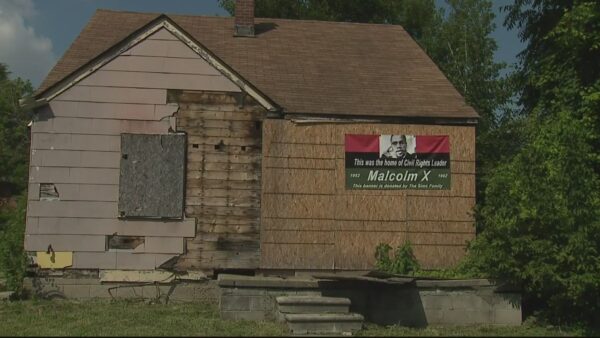An early home of civil rights leader Malcolm X has been placed on the National Register of Historic Places. The site in Inkster, Michigan, serves as the home for Malcolm X after he was released from prison, and is where he started to formulate his religious walk in the Nation of Islam and met the Honorable Elijah Muhammad for the first time.

According to a press release from the Michigan Economic Development Corporation, the National Register of Historic Places, with the State Historic Preservation Office serving as the administers, have named the home a landmark site.
Michigan’s State Historic Preservation Officer Mark A. Rodman said, “A key aspect of the National Register program is to document and honor places that are associated with events that have made a significant contribution to the broad patterns of our history. People and places in Michigan played important roles in the Civil Rights movement of the mid-twentieth century. We are honored to join the city of Inkster in celebrating one of those roles with the listing of this home.”
Malcolm X lived in this house in Inkster, located at 4336 Williams Street, near Annapolis Ave. from 1952 to 1953.
His older brother Wilfred X and his family allowed the 27-year-old to come live with them after his release from a Massachusetts prison. He stayed in a second-floor bedroom, an area where the whole family would congregate to ritually pray together.
Malcolm Little, the freedom fighter’s birth name, was incarcerated in 1946 for burglary in a Charlestown state prison in the commonwealth. While there, in 1948, he was introduced through his siblings to the Nation of Islam and started to communicate with its founder, Hon. Elijah Muhammad. During his time there, he opted to change his life by developing himself as a reader — tackling books in the prison’s library in the areas of philosophy, history, literature and science.
He also started a writing campaign to the Massachusetts governor, where he demanded the right to practice Islam in prison. He participated in several activities that would shape his role in American history, including joining the prison debate team and working on his oratorical skills. His purposeful effort to change his life led to his eventual parole in 1952, Massmoment.org reports.
After his parole, his brother welcomed him into his home and his faith, introducing him to the Nation of Islam Temple No. 1 in Detroit. He joined the temple, one of only four in the country at the time, and by the end of that year, met the man he had been communicating with, Elijah Muhammad, face-to-face. At that meeting, he received from him the “X,” a symbol of his shedding of the slave master’s name he received as a child.
He also, PBS reports, after noticing that the faith had only about 400 members worldwide, started a recruitment effort to expand the reach of the religion that now posts over 50,000 members in 2022. He did his work developing this effort in the Inkster home.
Also around this time, at this home, the Federal Bureau of Investigation started to have active surveillance over his life, a government prying on his life that continued until his assassination in New York City in 1965.
“With so much of the physical legacy of Malcolm X lost over time, this house is all the more important,” said Todd Walsh, National Register coordinator of the Michigan SHPO.
“Its significance is not simply its association with Malcolm X, but its connection to Malcolm at an incredibly pivotal time in his life. This house will help us better understand Malcolm X, not as an icon, but as a human being. It will also help us understand his family and the important role that played in his development into one of the most important figures in American history.”
Getting the home in the registry is one of many steps to the house’s restoration. The agencies received a $380,000 grant from the National Park Service African American Civil Rights program to transform the home into a museum “that will focus on the life and significance of Malcolm X, advocacy, and as a youth learning center.”
Leading this effort is Project We Hope, Dream & Believe, a collective that has been working on getting this initiative moving for some time. On its website, the organization decided to launch the campaign for the house to become a historical landmark because “the house is a part of American history, Black history, and Inkster history.”
It further read, “our goal is to fix the home and make it into a museum for people to come visit, and to also use it as a learning center to help the youth with education work.”
The advocates pushed for it to be considered in the registry under the following categories: National Register Criterion A under the theme of Ethnic Heritage: Black or Social History.
Project We Hope, Dream & Believe executive director Aaron Sims said, “We are working hard toward rehabilitating and renovating the Malcolm X house, with the goal of transforming the home into a museum that will showcase Malcolm’s life history, with special focus on his human and civil rights activism, as well as his relationship to the city of Inkster, which he referenced in one of his final speeches.”
Tareq A. Ramadan, who serves as both Wayne State University professor and Project We Hope, Dream & Believe project manager, said, “We have also partnered with Wayne State University’s Anthropology Department to conduct archeological excavations around the home which, we hope, will provide further clues about what life was like in the neighborhood Malcolm lived in between 1952 and 1953.”
“Malcolm had a relationship with Wayne State too,” he continued. “In October of 1963, he gave a speech there in front of hundreds of students in the still-standing State Hall building, so it is befitting that the university and its students will be involved, again, today. For the city of Inkster, this is truly a momentous occasion, as Malcolm has become a true hometown hero, and Project We Hope, Dream & Believe, as well as the wider community, is deeply committed to the preservation of Malcolm’s legacy.”
The Inkster home is one of the few homes of Malcolm X still standing today.
More news from our partners:
A Lack of Capital: Why the Booming Cannabis Industry Is Leaving Black Americans Behind


